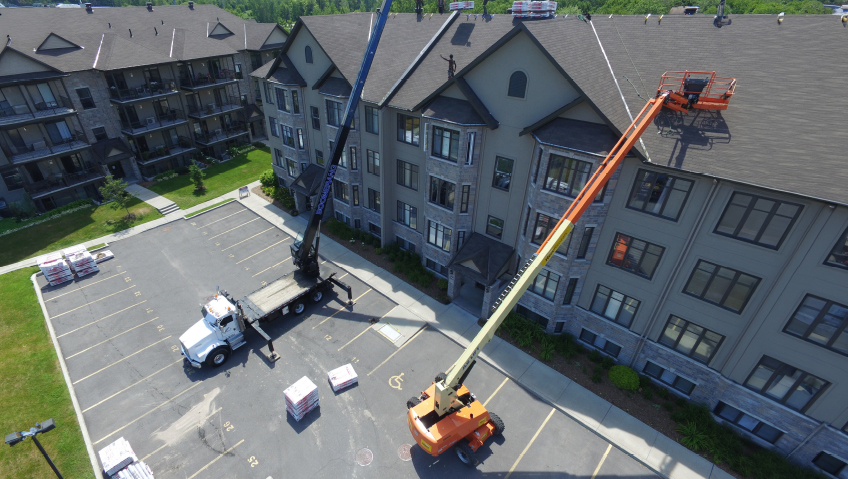From installation methods to new and sustainable materials, roofing is evolving, and the Canadian Roofing Contractors Association (CRCA) continues playing a vital role in this important building sector.
Formed in 1958 in Montreal, the CRCA was incorporated in 1960. A key reason for its creation was manufacturers pulling their warranties of work being done at the time. This saw roofing contractors come together to address this important issue. A board was created, followed by provincial associations that still exist today.
Over 60 years after its creation, Ottawa-based CRCA remains the voice of Canada’s roofing industry. Advocating, representing, supporting, and defending the interests of its more than 300 members, the Association informs its base about important national and international matters, including professional and technical issues and developments.
Active bodies under its aegis include National Technical Committees, an Associate Members Committee, a Workforce Solutions Committee, a Governance Committee, the RoofTech Steering Committee, and many other valuable initiatives enabling members to stay as up-to-date as possible.
Strong leadership and governance
At the CRCA, governance remains integral to its strategic mandate. Executive Director Jim Facette reports to a Board of Directors who reflect the membership and serve as stewards of the organization.
Within the Board, the CRCA has a Chair, Vice President, and Second Vice President, and a succession plan. New directors are voted in by the Associates. To raise awareness of competition law and trade procedures among its members, the Board recently underwent training.
“That kind of governance is exceptionally important,” says Facette. When he came in as Executive Director in mid-2023, he brought about 25 years of industry-association experience with him, including eight years (from 1995 to 2003) at the Canadian Construction Association.
One of the biggest advantages of being a CRCA member is communication. At meetings, board members regularly report on what’s happening on the ground—so to speak—in the roofing industry, and many also continue serving on their provincial boards as well.
Facette strives to attend as many annual general meetings of provincial associations as possible, making himself accessible to all. “When I speak to policymakers here in Ottawa—be they government officials or elected persons—I can say, ‘In your riding, we have these companies, and they have said ‘XYZ’ to me,’ so I’m able to make tangible what might otherwise be theoretical,” Facette says. “Boots on the ground are extremely important.”
Of its 388 member companies, Facette estimates that in each company at least two persons regularly review materials from the CRCA. One of the latest methods of keeping companies directly informed is the CRCA Members Hub (https://www.crcaacec.ca/articles/welcome-to-the-hub).
A digital platform, the Hub was initially going to be put out monthly, but because of overwhelming demand, information is now being updated almost every week. Members receive a push notification that there’s something new on the Hub which they can check out for themselves to see what is going on at the CRCA. And then, of course, there are direct phone calls from Facette and reports to board members to keep them informed.
Members small and large
At the CRCA, different membership categories and fees apply depending on the type of member, such as associates or contractors. Most members fall into the category of SMEs (small and medium-sized enterprises) or very large roofing product manufacturers, like Soprema and IKO. Some members, like Chair of the National Technical Committee, Stéphane Poissant, are smaller roofing contractors of about a dozen people who are also active in other areas, such as plumbing. Others, such as Lindsay Pochynuk, who became President/Chair last year, came to the Association through the local Saskatchewan member, the Saskatchewan Roofing Contractors Association.
Pochynuk was part of the national technical committee (from 2016 to 2019) before joining the CRCA board around 2020. He is a second-generation Chair of the board, with his father serving on the board around 2010. A roofing contractor with a family-run business, Pochynuk’s and his brother’s business has about 100 employees.
With a presence in all provinces and territories, the CRCA has eight provincial association members, contractors who wish to join the CRCA. Where a provincial association exists, these contractors must first be members of that association. And where there aren’t provincial associations—such as the territories and the provinces of Prince Edward Island and Newfoundland—they may join directly as at-large members.
“It’s an integrated membership from a structural perspective point of view,” explains Facette. “That said, associates and other organizations or businesses that have an interest in roofing may join us directly.”
The role of research
What some people don’t realize is that the CRCA has enjoyed a longstanding relationship with the National Research Council Canada (NRC) (https://nrc.canada.ca/en) going back to 1960. Founded in 1916, the NRC is the country’s largest federal research and development organization, dedicated to research and development in science and technology.
The CRCA has six to eight projects underway with the NRC at any given time, many having to do with materials, installation, and how materials work together. “Through our National Technical Committee, we bring the entire industry together with the NRC,” says Facette. “Going forward, this is important.”
The Association is involved with the U.S.-based National Roofing Contractors Association (NRCA) (https://www.nrca.net/) on certain projects, including joining technical meetings and sharing joint testing information. By being involved in this technical research with the NRC and NRCA, the Canadian Roofing Contractors Association can share valuable information with its members about different roof systems, ways to build, new materials, and more.
“There has been a lot of focus lately on green building and sustainability,” says Pochynuk, who, as a smaller contractor from Saskatchewan, appreciates access to valuable, shared information. This includes keeping all members up to date on certification and warranties, an activity administered through the provinces that further sets CRCA members apart from non-members in the roofing sector.
“A lot of criteria go into being a member and each province is different, but it takes into consideration insurance and years in business,” shares Facette.
Industry developments
To keep members informed about roofing industry developments, technical news, and much more, the CRCA publishes Roofing Canada Magazine (https://roofingcanada.com/roofing-canada-magazine/). Published twice a year, Roofing Canada reaches a subscriber audience of over 6,000. In addition, subscribers receive important news every two weeks via CRCA’s emailed ENews, and by attending the key roofing-industry trade show event, RoofTech.
Held over two days, RoofTech is filled with dozens of exhibitors, demonstrations, educational opportunities, presentations, panel discussions, and tremendous networking opportunities for roofing industry stakeholders. The next RoofTech is set for 2025, while the CRCA’s annual conference will be held this year in Victoria, B.C.
“Everybody and anything involved in roofing is at RoofTech, whether salespeople or all the major manufacturers of membranes, products, equipment, and software,” says Pochynuk. “We get the architects and the specifiers out and they love it, whether it’s new products or different roof systems they can see being installed hands-on.”
Addressing issues
When appropriate, the CRCA comments on public policies affecting the roofing trade.
As with other construction sectors, the biggest issue facing members is the shortage of labour. Many companies, like Pochynuk’s, want to grow but can’t find the people they need. “So what we do here at the CRCA is bring all that together,” says Facette. “We’ve been talking to the Minister of Immigration lately about how the current immigration program can work better for construction and roofers. I’ve had several meetings with him, his staff, and his department about some of the ideas that we have.”
Working with the Minister, the CRCA constantly communicates about the importance of the roofing trade and system improvements. To date, temporary workers cannot move from one province to another for jobs. This is problematic since many CRCA members work outside their home province and can’t move people around for jobs. Executive Director Facette has been explaining to Immigration, Refugees, and Citizenship Canada that the system needs to work better so the industry can attract people from around the world.
Another issue remains prompt payment legislation. Effective last December, published regulations finally came into force, ensuring that roofers receive prompt payment for federal projects. This way, roofers know they will be paid soon after the job is done. If contractors aren’t paid promptly, there are measures they can take to get paid.
Future of the sector
In the coming years, the CRCA sees sustainability becoming a growing issue in the roofing industry. ‘Green’ roofs are becoming a hot topic in the fight against climate change, along with ‘blue’ roofs that hold water, especially in the face of severe rain events like flash flooding. Rather than having excess water run through storm sewers and cause flooding—or having massive holding tanks on the ground—blue roofs are becoming an alternative.
Along with different technologies and materials, other key issues include increasing the use of recycled materials and members becoming more involved with entire building envelopes, including cladding, rather than just roofs alone.
The CRCA is in the very early days of discussions with the Federal Government, specifically the Treasury Board Secretariat, about environment product declarations (EPDs), which already exist in some other sectors, like the cement industry. More discussions will take place in the coming months, and the CRCA hopes to use a lifecycle assessment of the job in the bidding process since much more is being asked of roofers today.
“We are hoping to be able to use a lifecycle assessment of the job in the bidding process,” says Facette. “Right now, governments who put out work for tender tend to—almost exclusively—focus on price and the lowest bid. We are in some early talks to see how the Federal Government can use lifecycle assessment in those valuation processes as they demand greener buildings and more sustainability in the work they put out for tender.” This is crucial because, although the demand for greener technology is there, it doesn’t always come with the lowest bid.
Initiatives and advocacy efforts such as these demonstrate all that the Canadian Roofing Contractors Association does for its members on the ground while providing information to them that is timely and relevant. “The CRCA has a long history and we’re proud of it, but at the same time, it’s evolving,” says Facette. “Roofing today is using new technologies all the time, including artificial intelligence, and as an organization, we are changing with the times.”






